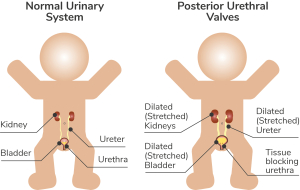Posterior Urethral Valves
The urethra in boys is made up of two main parts, the part in the penis (the anterior urethra), and the part near the bladder (the posterior urethra). Posterior urethral valves is a condition where baby boys are born with a blockage in the posterior part of the urethra which prevents them from weeing. This blockage can cause pressure to build up in the bladder, ureters (the tubes connecting the bladder to the kidneys), and the kidneys. Sometimes this pressure can cause significant damage to the boy's kidneys. In many cases, posterior urethral valves will be suspected before a boy is born, because the antenatal ultrasound scan has shown that the kidneys look swollen. Most of the time, boys with posterior urethral valves will need an operation early in life to remove the blockage from the posterior urethra.


Description of Diagrams
Normally, people are born with two kidneys which produce urine (wee). Each kidney is connected to the bladder by a tube called a ureter. This tube allows the urine produced by the kidneys to drain into the bladder. In a baby boy, a tube called the urethra then runs from the bladder through the penis to carry urine out when the boy goes for a wee. In posterior urethral valves, there is a blockage in the urethra, and this prevents the boy from going for a wee. The fact that urine cannot come out puts pressure on the bladder, ureters and kidneys, and causes them to become stretched.
More information about posterior urethral valves can be found on the websites below:

